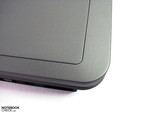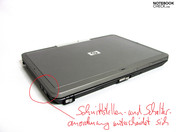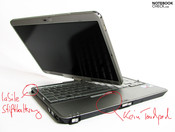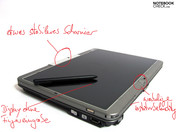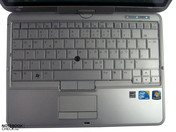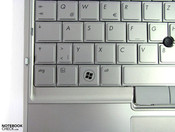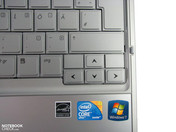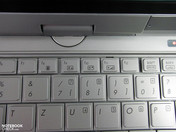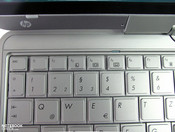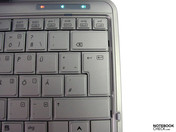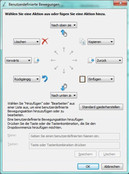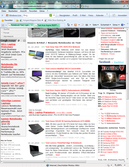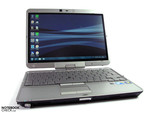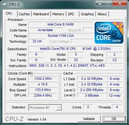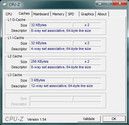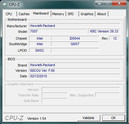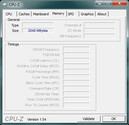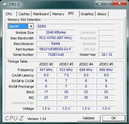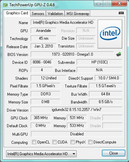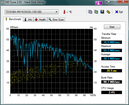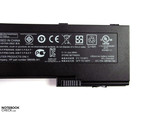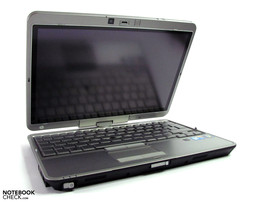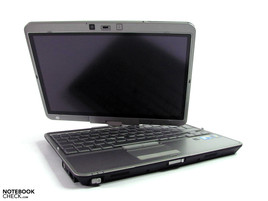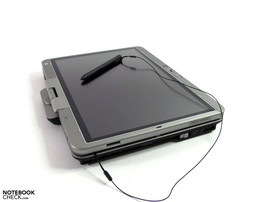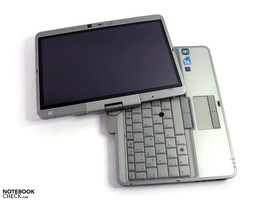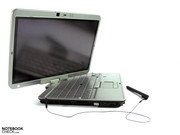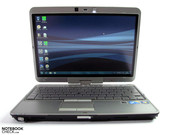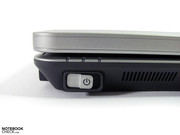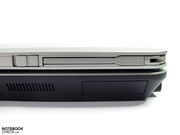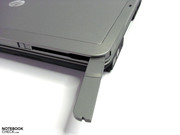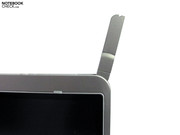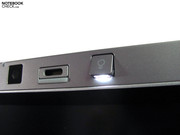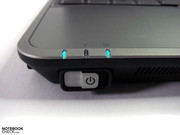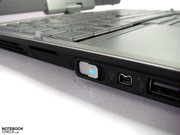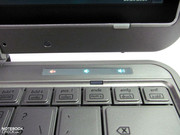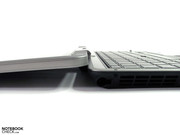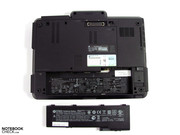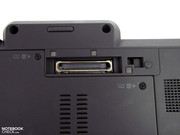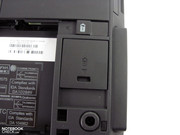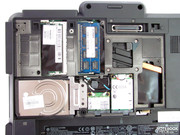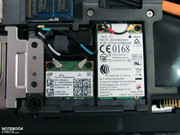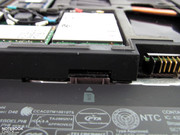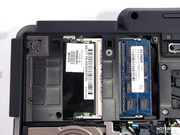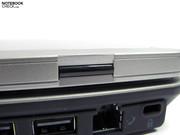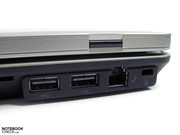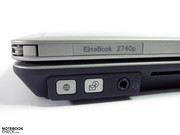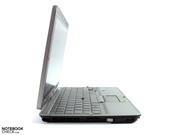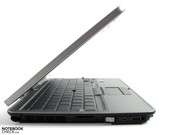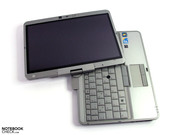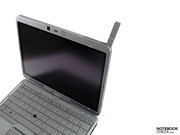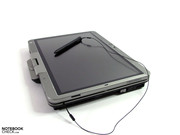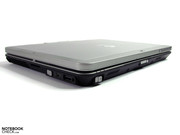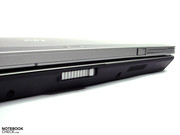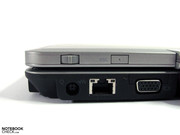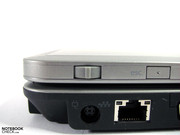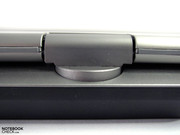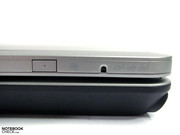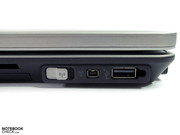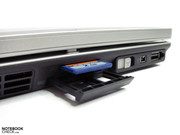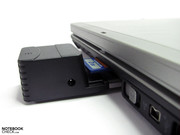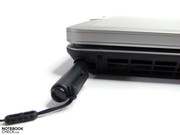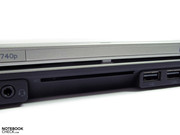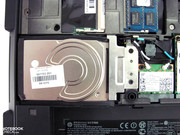Review HP EliteBook 2740p Notebook
The core component of a convertible notebook is its swivel display, which allows it to be used as a conventional notebook as well as a tablet PC. The main advantage of this type of construction is that it is possible to make use of the large number and type of interfaces contained on notebooks, while at the same time also being able to take advantage of the application and handling advantages of pure tablet PCs. HP has consistently developed the series starting from the HP 2710p to the HP Elitebook 2730p, right up to the tested Elitebook 2740p, and has above all made improvements to many details that are not immediately obvious to the user.
The primary components on our tested model are an Intel Core i5-540M CPU, Intel HD graphics, 2 GB RAM, 160 GB hard drive, UMTS, and Windows 7 Professional 32-bit. The prices currently start at about 1550 Euros for our tested model, and can significantly exceed 2000 Euros. The main differences in the configuration are due to the optional mass storage device (hard drive or SSD), the amount of RAM, and the selection of an integrated UMTS module.
Case
As ever the HP Elitebook 2740p also has a very solid well manufactured and altogether high quality case, just like its predecessor. The working area, display frame, and display lid are all covered with an aluminum surface which is slightly textured, something that has a positive impact both haptically and optically. Imprecise gaps, bendable surfaces, or loose panels? Definitely not the case! Even the display lid doesn't allow any bending, although in return it is also a bit thicker than usual.
The grippy black surfaces on the bottom part of the chassis have been kept although it is also primarily composed of aluminum, and provides a large panel behind which the usual components are located, as well as the required slot for the battery. The battery not only has to be removed to replace the battery, but also to gain access to the SIM card shaft beneath it.
Although the battery is located towards the front of the notebook, the weight distribution is only just well enough balanced to allow opening the display with one hand. The display is attached to the base of the notebook by a central swivel hinge, and can be turned around towards the back clockwise. While the HP2710p, which our editorial team has been using for a long time, did not allow for a lot of leeway with setting the display position, the tested model showed significantly more versatility in this respect. This could be a characteristic of the tested sample, since there haven't been any obvious changes to the hinge construction. In our case at least the display doesn't hold in place very well when rested on a moving surface, and shifted depending on the intensity of the movement.
When the lid is closed the display lid is held by a central locking mechanism. Between the display and the palm resting area there is still always a small gap of 1-2 mm, through which small items can get in between the two and potentially cause damage to the surfaces. This was also already the case with the predecessor, and is a problem with the construction of the case.
Immediately obvious differences between the Elitebook 2740p and the original HP 2710p are the somewhat partially newly arranged interface locations, the improved pen attachment, the newly available touchpad, the new arrangement of the keys (adapted to newer models), and the new clearly improved keyboard illumination in the display frame which no longer easily drops out.
Connectivity
The available interfaces haven't changed much. eSATA, USB 3.0, or a digital monitor output are still not included. 3x USB 2.0, Firewire 400 (4-pole), analog VGA output, card reader, modem, LAN, finger print reader, and a docking port cover the minimum requirements for professional use. Missing interfaces can at least be added via the ExpressCard 34 slot, which does however block the card reader and makes this unusable.
On the opposite side a rare smart card reader can be found, with which it is possible to implement security features. Disappointing is still, as with predecessor models and also the HP 8740w and HP 8740p, the slow data transfer rates from the Ricoh card reader, which offers a mere 1.7 MB/s when reading. Usual values lie at around 20 MB/s. Also the USB port is mediocre at the best of times, and offers an unusual 25.2 MB/s. Somewhat faster is the Firewire interface, which operates in the region of 33.4 MB/s, but also doesn't keep up with modern interfaces such as eSATA or USB 3.0.
Not understandable is however above all the low resolution of the VGA output with 1280x1024 pixels, that only has limited potential for feeding external displays. A notebook in this price range could easily be fitted with a digital display output, especially since most devices in the lower positioned HP Probook series even have one.
The interface distribution is a success, with the exception of the faux pas of the ExpressCard / card reader location, and offers a good mix of reachability and no obstructions from the connected periphery. The finger print reader is located on the side of the display frame, and thus very comfortable, almost intuitively reach- and usable.
Communication
Wireless connectivity options are provided by Bluetooth and W-LAN 802.11n, as well as UMTS (HSPA) and are integrated as we had hoped, and don't leave any wishes open. An antenna that is integrated into the display frame, and can be pulled out should provide for improved signal reception when using the 3G modem. To what extent this is really beneficial couldn't be tested by us, since we already maximum reception at our location without the additional length.
Accessories
Docking stations can be connected via USB 2.0, or the Dockingport on the bottom of the base unit. The HP 2740 Ultra-Slim Expansion Base (WA995AA) offers additional interfaces including eSATA and a digital display output for around 230 Euros. The relatively high price can additionally be justified thanks to an optical drive, which according to the description can also be used as a mobile unit. The Ultra-Slim Expansion Base is also especially interesting for users of the 2710p and 2730p models, since the previously available docking station (GD229AA) had neither a Displayport nor eSATA in its repertoire and was also more expensive.
Warranty
The warranty lasts for a generous 36 months as usual for the Elitebook series, and can be expanded via HP according to preference with further services or for an extended period of time.
Software
With respect to software the configuration merely has Microsoft One Note in addition to the operating system, and the usual manufacturer specific tools. At least the convertible has restoration media for the 32-bit version of Windows 7 despite of the missing optical drive. It was also previously possible to request the appropriate 64-bit versions from support, which would enable an easier potential intended future upgrade.
Input Devices
Keyboard
The keyboard on the Elitebook almost hasn't changed compared to the HP 2710p, but was adapted to the key shape of current models purely optically. It covers more or less the whole width of the case, and thanks to this offers normal sized keys. Many special functions are available via the usual FN combinations, and wireless modules, email, and browser even have extra hardware switches.
Not quite as firm as with the HP 2710p is the keyboard base, which can be bent a little in the central area. Otherwise the keys offer a short travel, a well defined pressure point, and a pleasing end stop sound. The key labeling may be a lacking some contrast, but can be illuminated by the light in the display frame.
Touchpad
Initially the case, which was as already mentioned previously also used for the HP 2710p, was not intended for an integrated touchpad. Nevertheless the decision to integrate one into the HP 2730p was made, and has led to compromises having to be made with respect to its shape and size. It is relatively small and spread sideways, so it can happen that the edges are accidentally straddled. Haptically the surface and precision are good, and make up for the limited size to a certain extent. The touchpad buttons are rubbery, and therefore grippy and easy to use. The pointstick can be controlled very accurately, and is a better alternative for practiced users that is also very grippy with easy to operated buttons.
Touchscreen
A special gimmick and attractive entry method using a pen (digitizer) or finger (multi-touch) directly on the display. The predecessor models could only accept entries via pen, direct entry using fingers is therefore a real new improvement (multi-touch not included with all configurations!).
After the first tests a calibration of the pen and finger should be performed to improve the accuracy as much as possible. The appropriate calibration tool can be found in the control panel. Despite calibration the inaccuracy is still about 2 mm at the edges of the screen. In these areas it can happen from time to time that the wrong item gets selected, and that the actual target e.g. cross for closing a window is missed. This deviation can be reduced by using the pen as opposed to the fingers, since the pen shows where the cursor with a small cross-hair before touching the display.
Altogether the entry using both methods works relatively well, and after a short period of getting used to them it is possible to develop a feel for which actions can be performed best by which methods. The pen is more suited for tasks demanding a high level of precision, but has its limitations when it comes to for example working with image editors (deviation about 0.5-1 mm away from the edges).
In return free hand drawings, illustrations, and notes can be added much more intuitively directly on the display, than would otherwise be possible for example using a graphics tablet. The domain of the finger entry is definitely the browsing between folders, opening and closing windows, surfing the internet, or perusing of documents. Finger gestures can be adapted individually, and assigned separately.
Display
The 12" UWVA Illumi-Lite LED display integrated into the HP 2740p comes in the meanwhile old fashioned 16:10 format, and provides a resolution of 1280x800 pixels. As already with the HP 2710p, a special outdoor display with particularly high brightness is available as an alternative, and can be found in some configurations, such as for example the WK300EA. The pixel density lies at just about 125 DPI, and provides a good combination of displayed size and available desktop space. Additionally this also allows a more or less problem free finger entry without constantly having to sharpen nails.
The orientation of the display can be manually adjusted via a button in the display frame, or can automatically adjust itself by turning the display e.g. when turning the display into the tablet position, this causes the orientation to change to portrait mode. This only works clockwise as already mentioned, and is reversed turning anti-clockwise.
| |||||||||||||||||||||||||
Brightness Distribution: 87 %
Center on Battery: 199 cd/m²
Contrast: 905:1 (Black: 0.22 cd/m²)
32.74% AdobeRGB 1998 (Argyll 3D)
46.63% sRGB (Argyll 3D)
31.68% Display P3 (Argyll 3D)
The display is made by SEC and is covered with a touch sensitive layer, that is not very reflective despite of a relatively smooth surface. The backlight reaches a maximum of 204 cd/m², and this together with 8 further localized measurements leads to an average of 191.9 cd/m². This results in a good illumination of 87%, that characterizes itself primarily due to the brightness reduction compared to the display frame. This is hardly noticeable during normal office or application use, but does stand out when it comes to image editing or predominantly single colored backgrounds.
In order to adjust the brightness level for improved ergonomics the tested model has a brightness sensor integrated into the lower display frame. This adapts the illumination depending on the surrounding ambient lighting conditions, and thus relieves the user of some additional configuration tasks. Those that are not satisfied with this, or want to use the full display brightness in dark surroundings, can do this via a FN combination or deactivate a control field. Manually the brightness can be adjusted in 19 steps from 9 cd/m² up to a the maximum. 100 cd/m² is reached with a setting of 14, and 131 cd/m² with setting 16.
The relatively decent brightness of on average about 200 cd/m² is fully available when in battery mode (deactivate brightness sensor!), and therefore also offers good conditions for relaxed working outdoors together with an anti-glare surface. For direct sunlight or especially sunny days the display is however not suitable since the LEDs can no longer trump the ambient light under these conditions, and thus requires a place in the shade. For such purposes the alternatively available outdoor display should be more appropriate.
While the color space determined by us is still smaller than that on other standard notebook displays, the contrast level of 905:1 can definitely provide for a positive feature. This is significantly better than many other multimedia notebooks. Black display contents also look very black, and colors appear much more saturated than we are used to from most notebook displays.
The viewing angle stability can be classified as very good both vertically and horizontally, as would be expected from a tablet. Inversions more or less don't take place at all, and color and brightness changes only occur at very extreme angles to the sides. The recognizability is always very good, and doesn't indicate any limitations.
Performance
While the predecessor models adopted Ultra Low Voltage and Low Voltage CPUs with correspondingly weak performance, the current revision has not had to make any compromises with respect to performance, and contains a regular Core i5-540M CPU with integrated Intel HD graphics in the tested model. This belongs to the current Arrandale family and contains performance enhancing features such as Turbo Boost (2.53 - 3.06 GHz clock speed) and Hyper-Threading (simultaneous processing of 4 threads). The whole package is completed with a 2500 MHz fast FSB and a 3 MB large L3 cache. The TDP lies at 35 Watts, which already includes the graphics unit and the memory controller, contrary to the predecessor models.
The CPU case contains an integrated graphics unit, and can provide clock speeds from 366 MHz up to 766 MHz, in order to adapt the performance capabilities and power consumption according to the requirements. Full-HD videos for example were played back with 500 MHz using the graphics chip.
Further to this we find 2 GB of DDR3 RAM, which can be expanded to 4 GB without difficulties since there is still one unused slot available. Those that opt for the maximum possible 8 GB RAM, will then have to use 2x 4 GB RAM modules.
The benchmark results offer satisfaction and show evidence of a particularly good CPU performance from the system. The wPrime 1024m calculation is completed in 626s, and SuperPi 32m in 867s. The Cinebench R10 32-bit benchmark gives 3120 (single) and 6545 (multi) points, while Dhry- and Whetstone give 33050 and 26980 points respectively. With these results the performance may be at the back end of the pack of other Core i5-540M CPU tested devices, but are very respectable for a 12" notebook. See our comprehensive CPU benchmark list for more details.
The Intel HD graphics integrated into the case of the CPU may be the currently best variant with a clock speed of 766 MHz, but is still not really suited for demanding 3D applications such as games or CAD. With Open GL shading in Cinebench R10 gives a score of 1710 points, while giving a score of 1921 points in 3D Mark '06, and no result at all with 3D Mark Vantage since this repeatedly always crashed at the same stage of the benchmark.
Full-HD videos are played back smoothly using the GPU with the appropriate player and DXVA support, the clock frequency of 500 MHz during this scenario was considerably below the maximum possible 766 MHz. As was already established with the Acer Travelmate 8172, the Elitebook HP 2740p was found to have an unfavorable power configuration set for the graphics properties. In battery powered mode we found this to be set to maximum performance, which would have negative implications for the battery run time, and when powered from the AC supply this was set to maximum battery life, which led to a desktop performance index of 2.2. Wrong way around! After reconfiguring these settings the full clock speed was reached, and the performance index jumped to a value of 3.9.
| PCMark Vantage Result | 5038 points | |
Help | ||
The application performance was performed and evaluated by us using our general impressions while using different image and text processing applications, as well as with the help of the PC Mark Vantage benchmark. What is especially noticeable in this case was the weak hard drive performance, which more or less had a bottleneck effect on the total performance depending on the application area. The starting of applications, transferring of data, or the opening of files is carried out at a noticeably more leisurely pace than would be expected from a 2.5" hard drive or even other SSDs.
| 3DMark 05 Standard | 2723 points | |
| 3DMark 06 Standard Score | 1421 points | |
Help | ||
The 160 GB hard drive used in the HP 2740p is kept in the 1.8" format as in the HP 2710p, but has a significant advantage in comparison. Instead of a PATA-ZIF connection, a SATA II interface is used as already in the HP 2730p, which provides for a greatly increased choice when it comes to the selection of a possible alternative mass storage device. The search for an appropriate alternative above all solves the problem of the leisurely working speed of the Toshiba MK1633GSG in the tested model. Although the technical details with 16 MBs of cache, and a speed of 5400 RPMs sound good for a 1.8" drive, the model tested by us only achieved an average transfer rate of 38.1 MB/s, which is on the disappointing side. See our comprehensive HDD benchmark list for further details. Those that can compromise on storage capacity in this area, can find a 64 GB 1.8" SSD with clearly better performance from about 110 Euros.
Emissions
System Noise
The system noise is constantly noticeable, but generally far from being annoying. When under a low load it happens from time to time that the cooling fan switches itself off completely which only leaves the operating noise from the hard drive to be heard. This only happens after taking a glance at the BIOS though, if the constant operation of the cooling fan is disabled for when the notebook is powered from the AC adapter (fan always on while AC Adapter). Now it would be possible to have an almost completely silent device during low load scenarios with the addition of an SSD instead of the included hard drive.
Since this was not the case, we measured a minimum of 32.4 dB(A) using the energy efficient profile, 34.7 dB(A) using the balanced profile, and 36.1 dB(A) using the high performance profile, operating with a low load in all cases. These noise emissions are interrupted for longer periods with a reduced fan operation from time to time. A hectic increasing and decreasing, or high frequency noises were not noticed by us.
With a medium load the noise volume is noticeably increased to 38.8 dB(A), which could get unpleasant on a constant basis. The seldom in practice encountered scenario of a full load finally raises the noise to an annoying 45.2 dB(A).
Altogether most of the usual tasks such as using office applications, surfing the web, using Skype, editing images, or administering databases could be performed using the energy efficient profile thanks to the abundant performance reserves, which rewards the user with lower system noise.
Noise level
| Idle |
| 32.4 / 34.7 / 36.1 dB(A) |
| HDD |
| 32.4 dB(A) |
| Load |
| 38.8 / 45.2 dB(A) |
 | ||
30 dB silent 40 dB(A) audible 50 dB(A) loud |
||
min: | ||
Temperature
Development of heat on the surface of the case is more or less non existent and can most likely be attributed to the thermally conducting case material as well as the relentless cooling fan operation. Even after a prolonged period of full load there is a mere maximum of 36°C measurable at certain points, which couldn't lead to any possible negative implications at any time. Using the notebook rested on your lap, especially in tablet mode, is possible without any problems.
(+) The maximum temperature on the upper side is 33.3 °C / 92 F, compared to the average of 35.4 °C / 96 F, ranging from 19.6 to 60 °C for the class Convertible.
(+) The bottom heats up to a maximum of 36 °C / 97 F, compared to the average of 36.8 °C / 98 F
(+) In idle usage, the average temperature for the upper side is 21.9 °C / 71 F, compared to the device average of 30.3 °C / 87 F.
(+) The palmrests and touchpad are cooler than skin temperature with a maximum of 24.9 °C / 76.8 F and are therefore cool to the touch.
(+) The average temperature of the palmrest area of similar devices was 27.9 °C / 82.2 F (+3 °C / 5.4 F).
Loudspeakers
The high frequency orientated loudspeakers are sufficient for background audio, YouTube videos, and system sounds. The missing bass and mid range frequency response make using these for watching movies, showing presentations, or playing back hi-fi music impossible. In these cases separate external speakers or headphones should be used via the audio output.
Battery Life
HP normally equips the Elitebook 2740p with a 44 Wh strong 6-cell battery, which according to the manufacturer should have run times of up to 6.5 hours. In our case a 39 Wh battery (BS556AA, costs approx. 230 Euros separately) with an especially long life expectancy (3 years) was included. The battery life can be extended by adding an additional 6-cell battery Ultra-slim battery (RX932AA, 46 Wh, approx. 210 Euros), or the normal primary 6-cell battery (AH547AA, 44 Wh, approx. 130 Euros) instead.
The minimum power consumption we measured coming from the AC power supply was 9.8 Watts. Depending on the power consumption profile settings this increases to 13.2 Watts and up to 19 Watts using the high performance profile. With a medium load the power consumption then rises to 35 Watts, and with a full load to a maximum of 56 Watts.
| Off / Standby | |
| Idle | |
| Load |
|
Key:
min: | |
The battery life determined using the Battery Eater Readers test (longest possible battery life with minimum display brightness, maximum power saving settings, and disabled unnecessary components) was 336 minutes, and leads us to believe that there are some additional efficiency improvements that are not active when the notebook is powered from the AC supply. From a purely mathematical perspective, the battery life with respect to the battery capacity indicates a power consumption of 6.4 Watts, which is very respectable for a device with these performance capabilities.
In addition to this, even if only just, derived from the AC power supply consumption, the resulting run time of 241 minutes which we reached while surfing the web with a Wi-Fi connection and full display brightness, would indicate a calculated power consumption of 9.75 Watts. Normal resolution movies played back from the hard drive lasted for 162 minutes, and full-HD movies for about 2 hours.
Using the Battery Eater Classic test (shortest possible battery life with all components enabled, high performance profile, and maximum display brightness) the battery only lasted just over 1 hour, and mathematically once again consumes less power than the maximum power consumed when powered from the AC supply. In this case the Classic test should also be a possible cause of this result, since it is far less taxing than the Prime and Furmark tests.
Verdict
The HP Elitebook 2740p is a beautiful and very flexible technology device. Despite of a missing optical drive it doesn't belong among the lightest 12" notebooks with a weight of 1.8 kg, and can only operate for a maximum of 6 hours without an AC power supply which doesn't exactly set any new records, but still provides a good portion of mobility.
The included interfaces are still good despite the fact that some of the newer ports are not available, and that these sometimes show less than ideal performance. The tested model profits particularly thanks to the wireless features including UMTS. The case is robust, stable, and has a high quality appearance.
Smaller gimmicks such as appealing separate hardware switches, a sensor panel for control of the sound system, and the neat keyboard illumination are not especially important, but add to the general visual appeal.
Highlights are of course the above average CPU performance, and the very good display with pen and finger input possibilities that also allow for new application areas to be available. That the system performance is restrained is primarily due to the slow hard drive, which also prevents a better system noise level when the notebook runs with a low load.
The most prominent reason for not buying this notebook for most users will likely be the high price. A good 1500 Euros isn't exactly a pittance, and will possibly be followed by the further addition of external components such as an SSD, or an alternative battery.
Those that do not necessarily require the touch sensitive screen or even the high performance CPU, could for example opt for the predecessor series HP Elitebook 2730p, which is already available from a retail price of 700 Euros (with UMTS 800 Euros), an interesting alternative in the professional convertible world.





